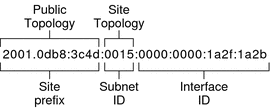Unicast Addresses
IPv6 includes two different unicast address assignments:
-
Global unicast address
-
Link-local address
The type of unicast address is determined by the leftmost (high order) contiguous bits in the address, which contain the prefix.
The unicast address format is organized in the following hierarchy:
-
Public topology
-
Site (private) topology
-
Interface ID
Global Unicast Address
The global unicast address is globally unique in the Internet. The example IPv6 address that is shown in Prefixes in IPv6 is a global unicast address. The next figure shows the scope of the global unicast address, as compared to the parts of the IPv6 address.
Figure 3–3 Parts of the Global Unicast Address

Public Topology
The site prefix defines the public topology of your network to a router. You obtain the site prefix for your enterprise from an ISP or Regional Internet Registry (RIR).
Site Topology and IPv6 Subnets
IN IPv6, the subnet ID defines an administrative subnet of the network and is up to 16 bits in length. You assign a subnet ID as part of IPv6 network configuration. The subnet prefix defines the site topology to a router by specifying the specific link to which the subnet has been assigned.
IPv6 subnets are conceptually the same as IPv4 subnets, in that each subnet is usually associated with a single hardware link. However, IPv6 subnet IDs are expressed in hexadecimal notation, rather than in dotted decimal notation.
Interface ID
The interface ID identifies an interface of a particular node. An interface ID must be unique within the subnet. IPv6 hosts can use the Neighbor Discovery protocol to automatically generate their own interface IDs. Neighbor Discovery automatically generates the interface ID, based on the MAC or EUI-64 address of the host's interface. You can also manually assign interface IDs, which is recommended for IPv6 routers and IPv6-enabled servers. For instructions on how to create a manual EUI-64 address, refer to RFC 3513 Internet Protocol Version 6 (IPv6) Addressing Architecture.
Transitional Global Unicast Addresses
For transition purposes, the IPv6 protocol includes the ability to embed an IPv4 address within an IPv6 address. This type of IPv4 address facilitates the tunneling of IPv6 packets over existing IPv4 networks. One example of a transitional global unicast address is the 6to4 address. For more information on 6to4 addressing, refer to 6to4 Automatic Tunnels.
Link-Local Unicast Address
The link-local unicast address can be used only on the local network link. Link-local addresses are not valid nor recognized outside the enterprise. The following example shows the format of the link-local address.
Example 3–1 Parts of the Link-Local Unicast Address

A link-local prefix has the following format:
fe80::interface-ID/10
The following is an example of a link-local address:
fe80::23a1:b152
- fe80
-
Hexadecimal representation of the 10-bit binary prefix 1111111010. This prefix identifies the type of IPv6 address as link local.
- interface-ID
-
Hexadecimal address of the interface, which is usually derived from the 48-bit MAC address.
When you enable IPv6 during Solaris installation, the lowest numbered interface on the local machine is configured with a link-local address. Each interface requires at least one link-local address to identify the node to other nodes on the local link. Therefore, you need to manually configure link-local addresses for additional interfaces of a node. After configuration, the node uses its link-local addresses for automatic address configuration and neighbor discovery.
- © 2010, Oracle Corporation and/or its affiliates
